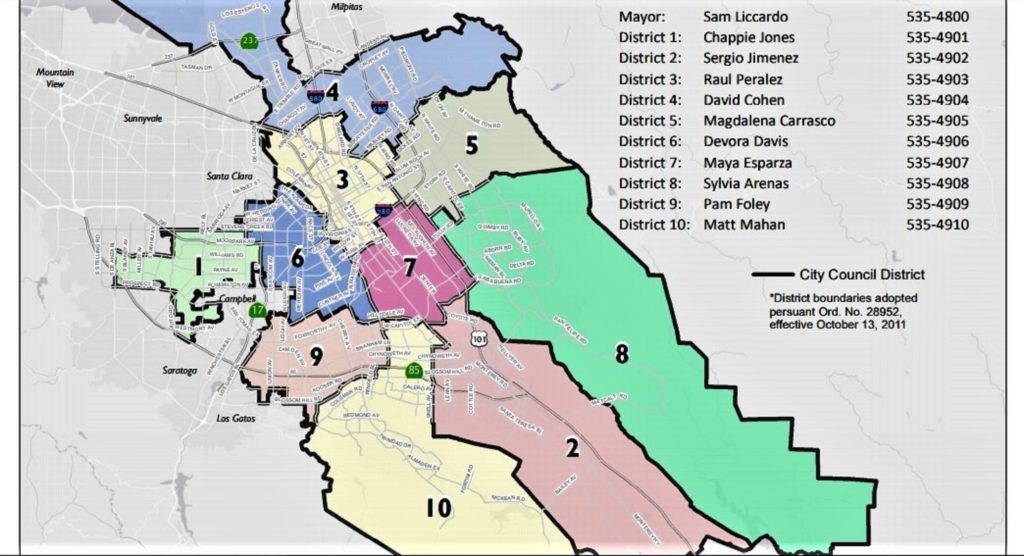San Jose is getting ready to redraw its 10 City Council districts—and will decide whether some populations should be grouped together based on common interests.
“How do (you) articulate whether some are more important than others, and what are the criteria?” asked Angelo Ancheta, director of the Community Law Center at Santa Clara University, at a recent Redistricting Advisory Commission meeting.
Redistricting, or the redrawing of electoral maps, occurs at the local, state and national level and follows the release of census population data every 10 years.
Census data show that San Jose’s population grew by about 57,000 since 2010, though the city shrunk by 13,000 people between 2019 and 2020. The city had 1.01 million residents in 2020, meaning each new council district should have a population of roughly 101,000 people.
The commission studied a concept known as “communities of interest,” or populations with common social or economic interests drawn within a single district to ensure fair representation.
San Jose has considered communities of interest before, though usually in the context of individual neighborhoods such as Willow Glen, according to San Jose State University political science professor Terry Christensen.
“The council and the city in general are talking about issues of equity,” Christensen said. “To me, it sounds like it may be broadening that definition to more class-based interests.”
There’s no clear-cut definition of what a community of interest is—each jurisdiction must decide which groups need fair representation, according to Jonathan Mehta Stein, executive director of open government group California Common Cause.
Mehta Stein said examples of communities of interest include San Diego’s historical LGBTQ+ neighborhood of Hillcrest, or low-income immigrant communities who live on one side of a railroad track.
“A group of folks who really care about one cement plant and the pollution coming from that cement plant… they have a shared interest around land use and environmental justice,” he said.
Communities of interest need to be defined carefully in order not to discriminate on the basis of race, Ancheta said.
“You’re in pretty safe ground if you’re looking at race in tandem with other factors,” he said at the meeting. “Don’t just say, ‘Well, here’s a Latino district, and we’re just drawing it because we want to keep Latinos in the same district.’ You have to be more careful about how you construct the district and what your justifications are.”
Five of San Jose’s 10 council districts are currently represented by Latinos. Four councilmembers are white, and one—Vice Mayor Chappie Jones—is Black. Though San Jose is home to more than 100,000 Vietnamese-Americans, the council’s sole Vietnamese-American councilmember was voted out last year.


On Oct. 27, the City Council passed a resolution requiring the commission to create districts that give racial minorities an equal chance of participating in the political process. But Ancheta said communities of interest aren’t always drawn around race or ethnic background.
“People who live near an airport may have particular concerns that they have in common,” Ancheta said. “It’s something as a body that I think you ought to talk through a little bit.”
In order to qualify for next year’s primary election, cities and counties need to approve final versions of redrawn district maps by Dec. 15, according to California Common Cause.
To get residents engaged in the redistricting process, San Jose will hold public hearings in each council district from August through September according to the city’s redistricting website. The first public hearing will be held on Aug. 7 at the Willow Glen Community & Senior Center.
The hearings will be “hybrid” events, meaning that residents can attend in-person or online, according to City Clerk Toni Taber.
“You are going to be a test case for doing community meetings in the hybrid world at community centers,” Taber said at last week’s meeting. “(A camera is) supposed to swivel automatically to whoever’s speaking, so that person will be on camera.”
At the meeting, Commissioner Enedina Cardenas said she’s still uncertain about what constitutes a community of interest and asked Ancheta for examples.
“To me, it’s still a very abstract idea,” Cardenas said.
Ancheta agreed that it’s a “fuzzy concept,” and said deciding which populations should be labelled as communities of interest will be difficult.
“How are you going to reconcile competing testimony for what constitutes a community of interest, or what the boundaries are for a community of interest?” Ancheta said. “A lot of that is judgment.”
California Common Cause has a template for residents to advocate for communities of interest. Readers can learn more about redistricting, including the schedule for public hearings, at the city’s website.
Contact Sonya Herrera at [email protected] or follow @SMHsoftware on Twitter.



Leave a Reply
You must be logged in to post a comment.